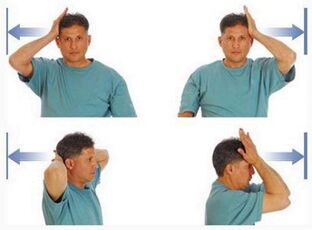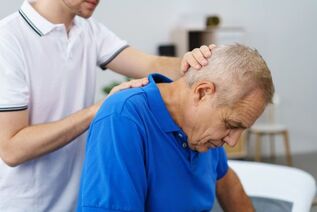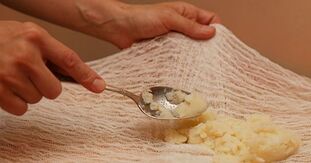Osteochondrosis can develop in any part of the spine, but most commonly affects the neck and lower back. This disease is inflammatory-dystrophic in nature and usually occurs in a chronic form. Osteochondrosis of the cervix is more often diagnosed in women, while men are more prone to osteochondrosis of the lumbar spine.
General Description
Most people spend their days sitting: at school, college, office, driving, or using a computer at home. As time goes on, many people begin to feel discomfort first and then feel pain after a long session. Posture deteriorates, a tendency appears, it is difficult to straighten or turn around.
This is how 1, the initial stage of osteochondrosis, is the easiest to deal with. If he does not take action, he threatens to become a chronic form in the future with regular exacerbations. In some cases, the case ends in a disability.
REFERENCE: The cause of osteochondrosis of the cervical spine is all half of the pathologies.
The clinical picture of cervical chondrosis includes:
- pain syndrome caused by compression of nerve roots. Depending on which vertebrae and discs are injured, the pain can spread to the shoulder, forearm, or entire arm. It is characterized by headaches, increased pressure;
- is a sensory disorder, especially in the hands and fingers. Possibly numbness, burning sensation, or creepy creep;
- Decreased muscle strength and tone on the affected side, sometimes muscle twitching and cramps;
- increased sweating, skin discolouration - pallor, redness;
- chest pain;
- vertebral artery syndrome occurs when one of the two arteries is pinched, accompanied by severe headache, tinnitus, nausea, dizziness, and, less commonly, swallowing disorder.
There are no medications that can completely eliminate the cause of osteochondrosis. But the simplest methods can get rid of your symptoms and prevent any relapses.
How to treat chondrosis?
In the acute phase, someone rarely goes without pain relief. The most popular and effective are cheap drugs based on sodium metamizole, as well as NSAIDs - non-steroidal anti-inflammatory drugs.
In case of severe pain, your doctor may prescribe painkillers as an injection, but more often they are supplemented with tablets and ointments. Complex therapy also includes physiotherapy, massage and exercise. Massages and therapeutic exercises are usually started after the relief of acute symptoms.
What you can do at home
Treatment of cervical osteochondrosis at home is a prerequisite that most doctors insist on. With drugs and physiotherapy alone, it is impossible to cope with the disease, they only temporarily eliminate the symptoms. The remission period can be extended with regular, dosed physical activity using self-massage techniques, therapeutic compressions, and booster infusions.
Impressive results can be achieved by following the instructions exactly and following the medical advice. Performing self-massage saves a lot of money, and using decoctions and herbal infusions instead of some medications reduces the negative effects of medications on the body.
Home therapy, like traditional treatment, helps to quickly stop the pain syndrome, normalize cerebral circulation, and improve sleep. With the help of the available products, you can remove nervousness and irritability, stabilize blood pressure, restore normal sensitivity of the neck and collar region.
gym therapy
Therapeutic exercises are classified as the main standard for the treatment of cervical chondrosis and are selected by an exercise instructor. The first 1-2 occasions are held in a clinic or health center and then the patient can train at home.
Exercise 1: PI (starting position) - standing, legs shoulder-width apart. Tilt your head right, left, forward and backward. All movements should be slow and smooth, especially taking your head back carefully and not throwing it back suddenly.
Exercise 2. Turn the head sideways from the same PI. At the extreme point, direct your gaze behind your back. Sometimes you can’t turn your head too much at first and you shouldn’t force events. Over time, the restrictive movement of the "block" disappears.
Exercise 3. Take back the shoulders, bringing the shoulder blades together as much as possible. Hold this position for a few seconds, then move your shoulders forward and round your back. The movement is similar to the famous "cat" but takes place in a standing position.
Another effective set consists of the following exercises:
- Standing or sitting, place your palm on your forehead and press your head against it, overcoming the resistance of your hands. Hold this position for 15-20 seconds.
- Place your hand on the back of your neck, press your head to your hands and your hand to your back.
- Place your palm on your right ear and apply mutual pressure, trying to tilt your head towards your right shoulder. Then change sides and tilt your head to your left shoulder, keeping your left hand on your left ear.
- Turns the head to the side, placing the palm on the left or right cheekbone. First, the hand rests on the right cheekbone and the head tries to turn to the right, overcoming the resistance of the hand. The palm then rests on his left face and the head turns to the left. The pressure time is 15-20 seconds.
- Grasp the bottom of the head with the thumbs on the chin and the others on the back of the head. Gently pull your head up, allowed to swing from side to side as "pulling the cork out of the bottle. "He cannot turn his head, the spine of the cervical spine needs to be adjusted. The duration of the exercise is 15-20 seconds.
- Spread your arms sideways and rotate first with your left, then your right, then both shoulders. This exercise is especially helpful for those who feel tension in the neck and shoulders.
- Standing or sitting with your back straight, "turn" your head from left to right and in the opposite direction, tilt your head as far as possible in the center and try to reach your chest with your chin. The number of repetitions is 10-12.

It is not necessary to complete the above complex if some exercises cause pain and severe discomfort. In agreement with your doctor, you can also hang on a horizontal bar or crossbar, swim, do water aerobics, and do other permitted sports.
Self-massage
Self-massage helps treat cervical osteochondrosis at home. Mild pressure on the neck prevents salt build-up, improves blood supply and tissue nutrition, and reduces the intensity of pain. During the procedure, the muscles relax, metabolic processes are accelerated, and blood pressure is stabilized.
If you wish, you can visit a massage therapist at the clinic or perform procedures at home. However, it is convenient to massage the neck alone after studying the basic techniques and determining the points that need to be worked out. It is also important to know which zones are best avoided or should be treated with caution.
The massage technique is quite simple and completely masterable. The basic rules are:
- direction of movement - from the center to the periphery, ie from the spine to the shoulder and the back of the head;
- The neck area should only be massaged with the help of fingers, without the use of any means;
- strong pressure is ruled out: you must act gently and subtly;
- the back and side muscles of the neck are caressed, rubbed and stretched;
- the massage is done in a sitting position;
- the session begins with a caress, continues with rubbing and kneading movements, and ends with a caress;
- procedure duration - 5-10 minutes.
You may use the Kuznetsov applicator unless contraindicated and approved by your doctor. This affordable and effective tool is a roller made of fabric or oil fabric, the elements of which - round or square spiked plates.
The applicator is easy to use - just place it under your head and lie on it. Soft needles bite into the skin, increasing blood flow and affecting the biologically active points in the neck. The duration of the procedure starts from a few minutes and gradually increases.
First aid for aggravation
If the lumbar cervix suddenly occurs, a doctor's appointment or a special home call is an ideal solution. If help is delayed, a number of measures should be taken to relieve pain and protect the structures of the vertebrae from possible injury.
Comfortable situation
First, you should enter the cervical spine and limit (preferably completely exclude) physical activity as much as possible. You should lie on a flat and medium-hard bed or a thick blanket on the floor. A floor that is too hard, such as a bare plank or a spacious feather bed, will not work.

For acute neck pain caused by osteochondrosis, it is recommended to wear a Shants collar that prevents the neck from moving or rotating freely. This reduces the load on the neck muscles and improves local blood circulation.
If you don’t have a Shants collar, you can make a house tire out of cardboard and cotton wool by attaching it to your neck.
REFERENCE: Before visiting a doctor, do not use warming gums and ointments, massage the neck. Such actions can in some cases cause very unpleasant complications.
LOCAL FUNDS
Ice or cold compresses are allowed during the first hours of the attack, but there should be a layer of fabric or gauze between the body and the body. This avoids hypothermia and increased pain.
The use of anti-inflammatory and analgesic ointments and gels based on diclofenac, ibuprofen, nimesulide and indomethacin is permitted. It is forbidden to use products such as Finalgon, Viprosal, Capsicam and other preparations that contain flammable components in their ingredients.
Warming ointments and rubs have a local irritating effect, increasing blood flow to the neck, which can increase swelling and compression of nerve endings. Particular care is needed in the cervical spine, as wrongdoing is accompanied by a sharp rise in blood pressure.
In case of worsening osteochondrosis, massage is not performed due to the risk of increased pain and reflex muscle cramps. In addition, cervical vertebrae are hypermobility, and any careless movement can aggravate the condition.
MEDICINES
Medication can help fight pain, but keep in mind that pain is a defense mechanism. By forcibly eliminating it, nothing prevents you from moving your head sharply, which makes the condition worse. Therefore, you should be gentle, preferably bed rest, for at least 2-3 days after taking the painkiller.
Severe pain, which is not suitable for stopping tablets and intramuscular injections, is relieved with the help of novocaine blockade. This procedure is performed strictly in a hospital setting: a local anesthetic is injected next to the injured vertebra and blocks the pain. Blockades are performed only as indicated and may cause side effects in the form of allergic reactions and infectious complications.
Prohibited Operations
Acute neck pain is a good reason for a doctor’s consultation and comprehensive examination. Only after an accurate diagnosis has been made will treatment tactics and, where appropriate, the most effective methods be determined.
It is categorically impossible to remove pain in any way - for example, to try to repair a dislocated vertebra on your own, or to seek similar help from a friend who is not a professional. Do not take uncontrolled doses of painkillers. Even folk remedies can be harmful if the diagnosis is not yet known.
Proper exercise is very important: if the movements during the exacerbation phase should be as limited as possible, physical activity should be extended after a few days. Exercises from the gym therapy complex help to improve blood circulation, reduce the intensity of pain and alleviate the inflammatory process. In addition, properly chosen exercises will help strengthen the spinal support lumbar spine.
How to cure osteochondrosis forever
Complex medication consists of several groups of drugs:
- NSAIDs and analgesics during exacerbation; muscle relaxants to relax muscles;
- chondroprotectors, restoring cartilage tissue in intervertebral discs;
- Vitamin and mineral complexes containing B vitamins
Various ointments, gels and patches, such as Nanoplast plaster, effectively complement the treatment. Today, pharmacies have a wide range of local therapies that can be used in both the exacerbations and healing phases:
- anti-inflammatory;
- chondroprotective;
- homeopathic.
Warming agents may be used when the acute symptoms have resolved.
Traditional methods
The honey-potato wrap is made from raw grated potatoes and honey. Both components are taken in equal amounts, mixed and placed on cloth or gauze. The compression is placed on the neck for about 45 minutes. The procedure is performed twice a week.

The wax or paraffin should be melted and applied to the sore spot to avoid contact with the spine. It is recommended to create such applications once every two days.
Knead the dough consisting of water and rye flour to a medium density, stretch the cake and attach it to the neck. Lubricate the skin with turpentine before lubrication. Cover the compress with polyethylene and a warm cloth, hold until a burning sensation appears, but for up to 15 minutes. You can complete the procedure every other day.
An herbal preparation for oral administration is prepared from the following ingredients in equal proportions:
- chamomile; yarrow;
- St. John's wort;
- marigold; thyme;
- dandelion leaves.
2hl. boil the mixture in a thermos, pour a liter of boiling water. Take a glass three times daily before meals.
This way, you can do a lot at home to get rid of an unpleasant disease like osteochondrosis. When performing all medical appointments, including taking medications, visiting physical and massage treatments, performing therapeutic exercises, there is every chance to avoid its progression and prevent relapses.
What to do?
Statistics show that more than 45% of people over the age of 35 have joint disease! It all starts small: where they were overstretched, where weights were lifted, where only their necks were blown. The joint is designed so that the main problems start with inflammation of the synovial fluid and then softening of the cartilage and consequently disability.
Important to keep in mind: joint disease takes you to a wheelchair in less than 3 years! The disease often progresses faster if you are overweight, as in this case there is a double load on the joints.













































